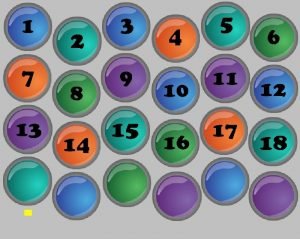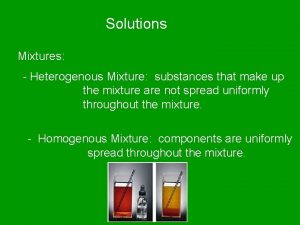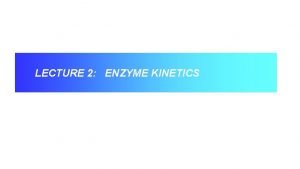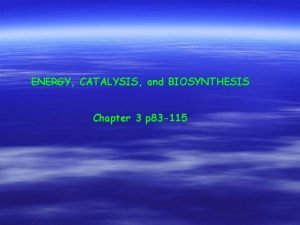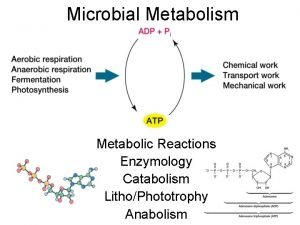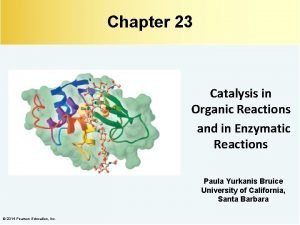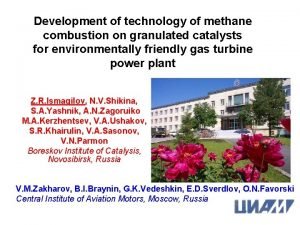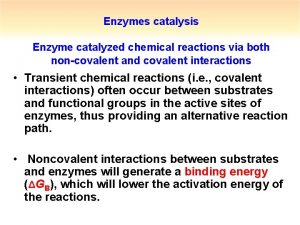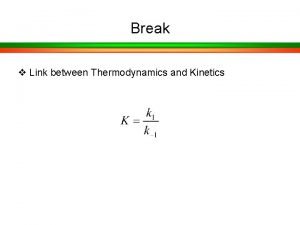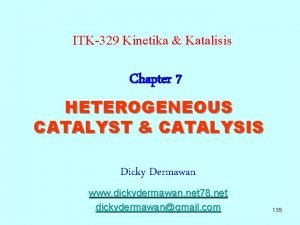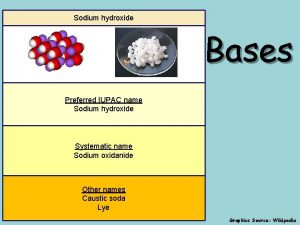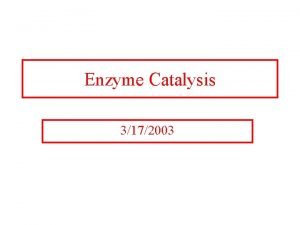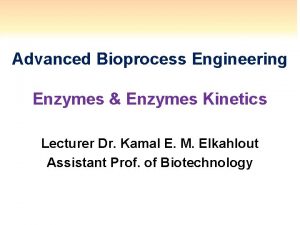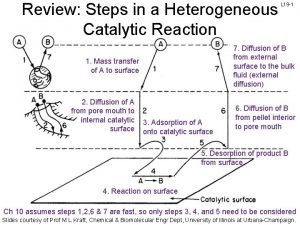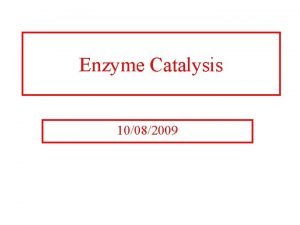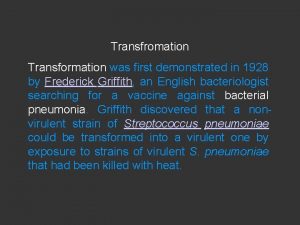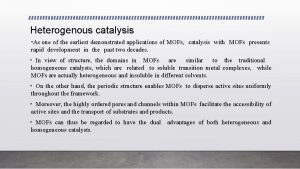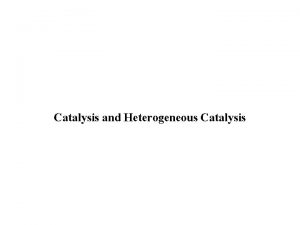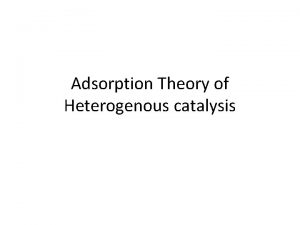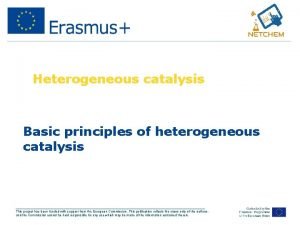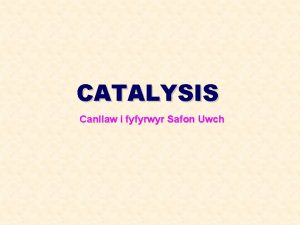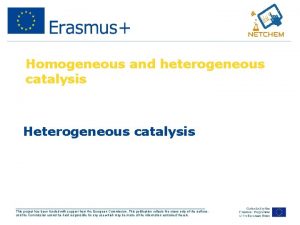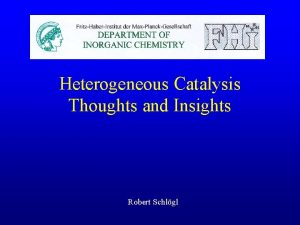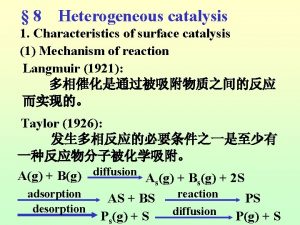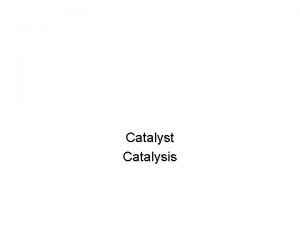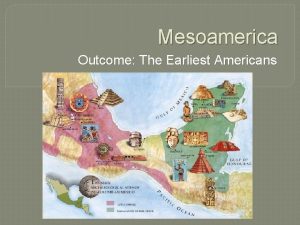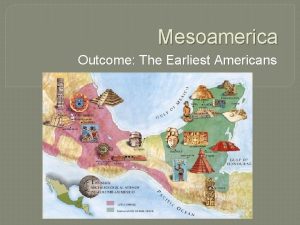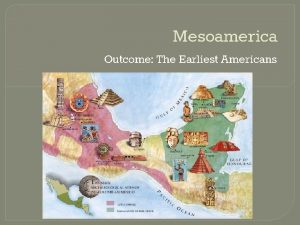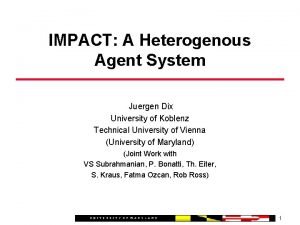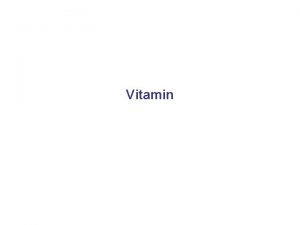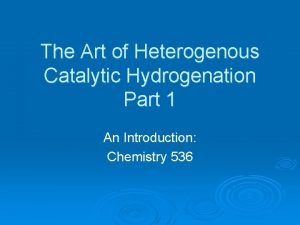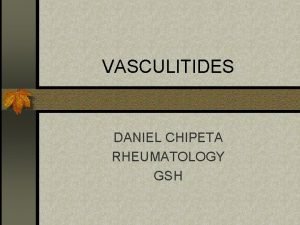Heterogenous catalysis As one of the earliest demonstrated



































- Slides: 35

Heterogenous catalysis • As one of the earliest demonstrated applications of MOFs, catalysis with MOFs presents rapid development in the past two decades. • In view of structure, the domains in MOFs are similar to the traditional homogeneous catalysts, which are related to soluble transition metal complexes, while MOFs are actually heterogeneous and insoluble in different solvents. • On the other hand, the periodic structure enables MOFs to disperse active sites uniformly throughout the framework. • Moreover, the highly ordered pores and channels within MOFs facilitate the accessibility of active sites and the transport of substrates and products. • MOFs can thus be regarded to have the dual advantages of both heterogeneous and homogeneous catalysts.

Heterogenous catalysis • Compared to the traditional porous catalysts such as zeolites and activated carbons, MOFs have much more diversified structures with highly tunable pore sizes (usually 0– 3 nm, up to 9. 8 nm) ranging from microporous to macroporous. • The uniform pore size and shape allows the accessibility of reaction substrates with specific shape and size, thus making it possible to differentiate substrates which are similar to each other. • MOFs typically have high surface areas from 1000 to 7000 m 2 g— 1 which favor the adsorption and enrichment of substrate molecules around the active sites, further benefiting the subsequent activation and catalytic conversion.

Heterogenous catalysis • The metal ions in MOFs are usually coordinated with organic ligands and solvent molecules, the latter of which can be readily removed by heating or vacuum with retained framework structures, creating the coordinatively unsaturated metal sites (CUSs). • The CUSs can act as typical Lewis acid centers for accepting electrons from the substrates and promoting their conversion to products. • Besides, functional groups on organic linkers can also be tailored for heterogeneous catalysis. • There is a variety of functional groups serving as active sites for catalysis. • The active functional groups can be linked to the MOF ligands, thereby resulting in a stable catalytic system. • The catalytic centers involved in pristine MOFs are usually limited to CUSs and the active sites on the linkers, which limit pristine MOFs to a certain scope of catalytic reactions.

Heterogenous catalysis • Fortunately, there at least two solutions to circumvent this problem. • The first solution is functionalized modification by grafting desired active sites onto either metal ions/clusters or organic linkers by the multivariate approach or postsynthetic modification. • The second is pore confinement and encapsulation. • Some MOFs have pores big enough to accommodate various catalytically active species like inorganic nanoparticles, metal complexes, small organic molecules, or even enzymes. The host–guest system can act as a complete catalytic system.

Heterogenous catalysis • Traditionally, MOFs have been widely explored as heterogeneous catalysts for various organic reactions. In recent ten years, MOFs and MOF-based composites have also shown excellent catalytic activities for energy-related applications such as photo- catalysis and electrocatalysis, which will continue to be one research frontier of MOFs in the future [129– 133]. • Active catalytic centers in MOFs can be generated in three different locations within the structure of MOFs, i. e. , at the metal centers, at the organic linkers, and at the pore space. • Metal centers can be readily generated in MOFs through removal of coordi- nated solvent molecules. • For example, the classical HKUST-1 gave open Cu 2+ sites upon the removal of coordinated water molecules, exhibiting Lewis acid activity in the cyanosilylation of benzaldehyde and the isomerization of terpene derivatives[134, 135].

MOF catalysts for heterogeneous organic reactions • MIL-101(Cr), composed of trimeric chromium(III) octahedral clusters interconnected by 1, 4 -benzene- dicarboxylate (BDC) anions, exerted Lewis acidity upon the removal of the terminally coordinated H 2 O molecules for better activity than HKUST-1 in the cyanosilylation of aldehydes, because of the stronger Lewis acidity of Cr(III) [136]. • Horike et al. reported a 3 D porous Mn 3[(Mn 4 Cl)3 BTT 8(CH 3 OH)10]2 (H 3 BTT = 1, 3, 5 -benzenetris(tetrazol-5 -yl)), built from chloride- centered square-planar [Mn 4 Cl]7+ units linked by BTT 3— ligands with 7 and 10 Å pores [137]. • Owing to the exposed Mn(II) centers, the MOF presented good catalytic activity for the cyanosily- lation of benzaldehyde (Fig. 6 a).

MOF catalysts for heterogeneous organic reactions • In addition to the pristine metal nodes, nickel ions were uniformly dispersed in Zr-based MOF NU-1000 through atomic layer deposition (ALD) and the resulting sintering-resistant single-site Ni catalyst turned out to be one of the best available hydrogenation catalysts based on earthabundant elements with high activity, long-term stability, and excellent regenerability [138]. • The catalyst was effective for both hydrogenation and ethylene oligomerization reactions. • Catalytically active functional groups can be incorporated into the organic linkers for MOF construction. For example, the sulfonic acid group (–SO 3 H) can be grafted onto the aromatic linker to fabricate MOFs such as MIL-101(Cr). • Akiyama et al. prepared MIL-101(Cr) containing partially protonated –SO 3 Na group using 2 sulfoterephthalate in the presence of HCl [139]. • With the strong Brønsted acid site on its pore surface, this MOF showed high activity in the catalytic cellulose hydrolysis. Lewis basic functional groups like pyridyl, amide and amino group can also be incorporated in organic linkers of MOFs to gen- erate basic catalyst.

MOF catalysts for heterogeneous organic reactions • Seo et al. synthesized a homochiral MOFs D- POST-1 with 1 D channels using the pyridyl group functionalized organic linker. • Bearing half of pyridine groups in channels, the framework possessed the basic sites for the transesterification of 2, 4 -dinitrophenyl acetate. • In addition to direct incorporation of functional groups, post-synthetic modification can also result in additional catalytic centers. • A molecular nickel complex was anchored to a mesoporous MOF (Ni@Fe-MIL-101) via postfunctionalization, generating a very active and reusable catalyst for the liquid-phase ethylene dimerization to selectively give 1 - butene, the activity of which was better than the corresponding molecular nickel diimino complexes. • The bipyridyl and phenanthroline-containing Ui. O MOFs were used as templates to incorporate cobalt catalysts through postsynthetic metalation. The resulting catalysts showed high activity, robustness, and recyclability for a wide range of reactions including alkene hydrogenation and hydroboration, alde- hyde/ketone hydroboration, and arene C–H borylation.

MOF catalysts for heterogeneous organic reactions • In addition to the catalysis at metal nodes and organic linkers of MOFs, incorporation of catalytically active complexes as guests into MOF pore spaces has been a widely adopted approach to generate MOF catalysts so far. • This approach benefits from the free choice of any catalytic centers and a vast number of MOFs that can be chosen as templates/hosts. Using an anionic bio-MOF-1 as template, positively charged Co 2+ ions were first exchanged into its framework by electrostatic interaction followed by reaction with 1, 2 -dicyanobenzene to form cobalt(II) phthalocyanine (Co–Pc) complex within the MOF’s nanospaces via confinement effect. • The resultant Co-Pc@bio- MOF-1 showed superior activity to catalyze styrene epoxidation reaction than the homogeneous Co-Pc counterpart. The ruthe- nium complex (t. Bu. PNP)Ru(CO)-HCl (t. Bu. PNP = 2, 6 -bis((di-tert-but ylphosphino)methyl)-pyridine) was encapsulated in Ui. O-66 through a solvent-dependent, aperture-opening process resulting from dissociative linker exchange reactions in the MOF. Compared to the corresponding homogeneous catalyst, [Ru] @Ui. O-66 showed improved recyclability, stability, and resistance to catalyst poisoning for the hydrogenation of CO 2 to formate.

MOF catalysts for heterogeneous organic reactions • In addition to metal complexes, metal nanoparticles (MNPs) are an important class of MOF guests with diverse functions, particularly in catalysis. • Platinum nanoparticles were sandwiched between an inner core and an outer shell composed of MIL-101 to generate a selective catalyst for the hydrogenation of a, bunsaturated aldehydes to yield unsaturated alcohols. • MIL-101 served as an effective selectivity regulator of Pt nanopar- ticle while maintaining efficient reactant and product transport owing to the porous nature of the material. • Without the MOF, the Pt catalysts alone would selectively hydrogenate the carbon –carbon group in preference to the carbon–oxygen group because the process is thermodynamically favored.

MOF catalysts for heterogeneous organic reactions • The sandwich catalyst overturned this selectivity. • An et al. used both the bipyridyl ligand Zr 6 (l 3 -O)4 (l 3 -OH)4 sites in Ui. O-bpy MOF to anchor the ultra-small Cu/Zn. Ox nanoparticles, preventing the agglomeration of Cu NPs and phase separation between Cu and Zn. Ox. • The resultant Cu/Zn. Ox@MOF catalysts showed high activity with a space–time yield up to 2. 59 g. Me. OH kg— 1 h— 1 , 100% selectivity and high stability.


• (a) Catalysis of the benzaldehyde cyanosilylation reaction over Zn [(Mn Cl) BTT (CH OH) ] [137]. Adapted with permission from Ref. [137]. Copyright 2008, American Chemical Society. (b) Schematic illustration of the synthesis of Ni(II) complex@Fe-MIL-101 for selective ethylene dimerization [141]. Adapted with permission from Ref. [141]. Copyright 2013, American Chemical Society (c) Schematic showing the beneficial effects of active site isolation in MOFs [142]. Reproduced with permission from Ref. [142]. Copyright 2013, American Chemical Society. (d) The de novo assembly of Co-Pc@bio-MOF-1 [143]. Reproduced with permission from Ref. [143]. Copyright 2014, American Chemical Society. (e) The controlled encapsulation of nanoparticles inside the controlled position of ZIF-8 particles [151]. Adapted with permission from Ref. [151]. Copyright 2012, Nature Publishing Group. (f) The design concept of achieving a tandem catalyst [167]. Adapted with permission from Ref. [167]. Copyright 2015, Nature Publishing Group. 3 4 3 8 3 10 2

MOF catalysts for heterogeneous organic reactions • The controlled spatial distribution of MNPs within MOFs is a challenging problem. • One interesting strategy is to use metal oxide both as support to load MNPs and as a sacrificial template to grow MOFs. • Pt NPs located near the surface of the MOF layers (Pt@ZIF-8 -‘sur’) was synthesized and showed exclusive catalytic activity for the hydrogenation of linear hexene but not the cyclic cyclohexene. • Such selectivity was rare in other related Pt NP-based catalysts. • The incorporation of catalytic centers into MOFs can also be achieved by modifying the conditions for MOF synthesis. • By adding glycine in MIL-101 synthesis, Lewis acid and base-like chromium hydroxide sites were generated in situ in MIL-101 and the material effectively catalyzes glucose isomerization in ethanol with comparable efficiency to the obtained by the Sn- containing Lewis acidic zeolites.

MOF catalysts for heterogeneous organic reactions • Lu et al. reported a general approach for encapsulation of the polyvinylpyrrolidone (PVP)- stabilized NPs with various sizes shapes and compositions into ZIF-8 which can be extended to other nanostructured materials. (Fig. ). • The spatial distribution of incorporated NPs within ZIF-8 crystals was also controllable by their addition sequence. • The Pt/PVP/ZIF-8 catalyst showed exclusive selectivity for n-hexene over its constitutional isomer trans-2 -hexene. • Not limited to metal nanoparticles, phosphotungstic acid (PTA) was recently encapsulated within NU-1000, a Zr-based MOF, and showed remarkable catalytic activity for the o-xylene isomeriza- tion and disproportionation at a high temperature of 523 K. • Using a simple PDMS coating method, surface hydropho- bic Pd/Ui. O-66@PDMS was successfully synthesized.

MOF catalysts for heterogeneous organic reactions • Remarkably, the hydrophobic PDMS coating facilitated the enrichment of hydrophobic substrates and thereby promoted interaction with Pd sites. • As a result, Pd/Ui. O-66@PDMS exhibited significantly improved catalytic efficiency in various reactions and enhanced recyclability compared to the pristine Pd/Ui. O-66. • By the integration of Pt nanocrystals and porphyrinic MOFs, PCN-224(M), Chen et al. reported a Pt/PCN-224(Zn) composite exhibiting excellent catalytic performance in the photo- oxidation of aromatic alcohols, based on a synergetic photothermal effect and singlet oxygen production of both Pt NCs and PCN-224(Zn). • MNPs/MOF composites can also be employed to realize synergetic catalysis and cascade reactions. • Chen et al. successfully synthesized bimetallic Pd. Ag alloy NPs (1. 5 nm) in the cavities of MIL 101. • The obtained Pd. Ag@MIL-101 presented great catalytic activity and selectivity toward one-pot cascade reactions, in which MIL-101 offered Lewis acidity and Pd. Ag afforded selective hydrogenation activity.

MOF catalysts for heterogeneous organic reactions • Yang et al. also reported the synthe- sis of Pd@MIL-101 composite with tiny Pd NPs, which exhibited excellent catalytic performance in tandem dehydrogenation of ammonia borane and reduction of nitro compounds. • Similar to nanoparticle, ionic liquid can also be incorporated in MOFs. Ding et al. confined imidazolium-based poly(ionic liq- uid)s (denoted as poly. ILs) into MIL 101 via in situ polymeriza- tion and the resultant poly. ILs@MIL-101 exhibited good catalytic performance for the cycloaddition of CO 2 at subatmo- spheric pressure in the absence of any cocatalyst. • In addition, MOF-derived single-atom catalysts (SACs), with the maximized utilization of metal atoms, have also shown ultra- high efficiency and selectivity in various organic reactions.

MOF catalysts for heterogeneous organic reactions • Sun et al. reported a facile method to construct a single-atom cobalt catalyst based on Zn. Co-ZIF materials, which displayed high activity and selectivity (>99%) for selective hydrogenation of nitrobenzene to aniline under mild conditions. • Very recently, Wei et al. discovered an unexpected conversion of noble metal nanoparticles into thermally stable single atoms at above 900 °C in an inert atmosphere. • The single-atom Pd catalyst exhibited even better activity and selectivity than Pd nanoparti- cles for semihydrogenation of acetylene. • The examples above demonstrate the great potentials of MOF-based SACs for heterogeneous catalytic processes.

MOF as asymmetric catalysts • Asymmetric catalysis is one specialized and highly practically useful area in which MOFs have turned out to have unique advantages. • The first reported MOF for asymmetric catalysis is D-POST-1 which contained a chiral ligand derived from -tartaric acid, presenting 8% enantiomeric excess (ee) for transesterification reaction [140]. D • Since then a great number of chiral MOFs have been developed and the ee values have been improved. • Wu et al. used a chiral bridging ligand containing two orthogonal functional groups [163]. The primary bipyridyl group can complex with Cd 2+ to form the homochiral MOF, and the secondary 2, 20 -dihydroxy group was used to react with Ti 4+ to generate catalytic centers. • The MOF system effectively catalyzed the Zn. Et 2 addition to aromatic aldehydes with up to 93% ee, comparable to the corresponding chiral homogeneous catalyst BINOL/Ti(Oi. Pr)4. • A different approach to generate chiral MOF catalyst is to postsynthetically attach chiral ligand to an achiral MOF.

MOF catalysts for heterogeneous organic reactions • Banerjee et al. demonstrated that -proline-based chiral ligands can be attached to the open metal coordination sites of MIL-101, and the resulting chiral MOF showed remarkable catalytic activities (60– 90% yields, 55– 80% ee) in asymmetric aldol reactions, including much higher enantioselectivity than the chiral ligands themselves. L • Cui and coworkers developed a homochiral biphenol-based MOF decorated with chiral dihydroxyl auxiliaries, which can be partially deproto- nated by nbutyllithium.

Photocatalytic reactions • Photocatalysis is one fast growing field for catalytic application of MOFs recently. • The three most important parameters of a photocatalyst are the spectrum-responsive range, the effective separation of electrons and holes, and the redox reaction efficiency of the charge carriers. • MOFs can present semiconductor-like behavior in that the organic ligands provide the highest occupied molecular orbital (HOMO) and the metal nodes provide the lowest unoccupied molecular orbital (LUMO). • Irradiation of MOFs by a suitable light source typically results in a ligand-to-metal charge-transfer (LMCT) process in which elec- trons from the ligands are transferred to the metal nodes, resulting in the electron-hole separation [173]. • Given theoretically unlimited number of organic ligands, improving the photore- sponsive range of ligands has been an important approach to tune the activity of MOF photocatalysts. MOF-based photocatalysts have been widely used for photocatalytic organic pollutant degradation, various organic reactions, hydrogen/oxygen pro- duction from water splitting, and reduction of CO 2.

Photocatalysis by MOFs • The early work in this area utilized amine-functionalized MOFs and extended the photoresponsive range from the typical UV to the visible range, however it was typically within the short- wavelength range of less than 450 nm. • Incorporation of other functional units like the strong visible light-absorbing por- phyrins further extends the photoresponsive range [174]. • In addition to ligand modification, other materials including semi- conductors, plasmon polariton-responsive metals, and even upconversion nanoparticles (UCNPs) have been incorporated in MOFs to improve photocatalytic activity [175, 176]. • Lastly, introduction of co-catalysts also could boost the activity of the whole system by inhibiting the combination of electrons and holes as well as providing additional active sites. • For example, platinum as a co-catalyst could trap electrons and facilitate the photocatalytic hydrogen production [175]. One significant chal- lenge of MOF catalysts is most studies so far have focused on half reaction like hydrogen production from water, and a sacrificial agent is needed to complete the other half reaction.

MOFs as Photocatalysts • Most recently, Liu et al. tried to couple photocatalytic H 2 production with organic oxidation transformation by hole oxidation to give value-added products in the absence of any sacrificial agent [177]. • The stability of MOFs also must be addressed especially when the photocatalytic reaction is carried out in water. In this section, we will focus on the latest developments of MOFs in light-driven energy conversion reactions including organic pol- lutant degradation, organic reactions, water splitting, and CO 2 reduction. • The MOF-catalyzed photocatalytic organic pollutant degrada- tion has been studied for dyes such as methylene blue, methyl orange, cresol red, coomassie brilliant blue and small molecules such as thiophene and phenol [178]. • It was common for such organic molecules to bear chromophores or conjugated systems to facilitate visible light absorbance. • In addition to the organic pollutants degradation, various organic reactions have been shown to be subject to photocatalysis by MOF catalysts. • The pho- toredox catalyst [Si. W 11 O 39 Ru(H 2 O)]5— was incorporated into the pores of copper(II)-bipyridine MOFs [179].

MOFs as photocatalysts • Direct Cu. II–O–W(Ru) bridges and the two metal centers synergistically catalyzed the C–C coupling of acetophenones and N-phenyl- tetrahydroisoquinoline with excellent conversion and size selectivity. A series of porphyrin-based MOFs were constructed, of which. ZJU-18 ([Mn 5 Cl 2(Mn. Cl-OCPP)(DMF)4(H 2 O)4]· 2 DMF· 8 CH 3 COOH· 14 H 2 O, H 8 OCPP = 5, 10, 15, 20 -tetrakis(3, 5 -bis • carboxylphenyl)porphyrin) catalyzed highly efficient and selec- tive oxidation of ethylbenzene to acetophenone in quantitative yields and a turnover number of 8076 after 48 h. • A number of amine-containing MOFs have been shown to be effective photocatalysts either by themselves or after suitable modification. • The zirconium centers in amine-functionalized Ui. O-66 -NH 2 turned out to be effective visible-light photocatalyst for selective aerobic oxygenation of various organic compounds including alcohols, olefins, and cyclic alkanes.

Photocatalysts • The reaction was substrate- and solvent-dependent, thus alcohols including benzyl alcohol, cyclohexanol, and hexyl alcohol and the cyclic alkane cyclohexane were oxidized to the corresponding aldehy- des and ketones with 100% selectivity. • Using the same MOF, Cd. S nanorods were decorated on the surface of Ui. O-66 -NH 2 through photodeposition at room temperature, presenting considerable photocatalytic activity for oxidizing various alcohol substrates. [182]. • It was assumed that charge injection from Cd. S into Ui. O-66 -NH 2 led to efficient charge separation. The aminefunctionalized NH 2 -MIL-125(Ti) demonstrated photocatalytic activity for the aerobic selective oxidation of amines to imines under visible light irradiation. • Depending on the structure of substrates, the conversion ranged from 41% to 100%, and the selectivity ranged from 45% to 93%. NH 2 -MIL-125(Ti) was post- synthetically functionalized with the dye molecule methyl red to improve light absorption over a wide range of the visible spec- trum and showed enhanced photocatalytic oxidation activity for oxidizing benzyl alcohol into benzaldehyde. • Titanium oxide (Ti. O 2) is considered as green catalyst for many different transformations. It was incorporated into mesoporous HKUST-1 to give a composite catalyst, which selectively oxidize benzylic alcohols into the corresponding carbonyl compounds.

Photocatalysis • In addition to inorganic nanomaterials which have been widely investigated for MOF catalysis, organocatalysts - or -pyrrolidin-2 -ylimidazole (PYI) were incorporated into a L D zinc-based MOF to generated two enantiomers Zn–PYI 1 and Zn–PYI 2, in which 4, 400 tricarboxyltriphenylamine (H 3 TCA) ligands were capable of initiating photoinduced electron transfer processes. • The homochiral MOFs catalyzed the light-driven asymmetric a-alkylation of aliphatic aldehydes in a heterogeneous manner, resulting in good conversion (61– 85%) and high selectivity (78– 92% ee). The enantiomeric selectivity of the MOF catalyst showed dramatic improvement to that of thecorresponding catalyst without MOF (~20% ee), attributing to the well-defined structure of the composite.

Photocatalysis • Water splitting contains two half reactions, water reduction which generates hydrogen and water oxidation which generates oxygen. • The hydrogen generation with MOF photocatalysts has been predominantly investigated due to the commercial and environmental value of hydrogen as a clean fuel. • By incorporat-ing the photosensitizer Ru(bpy)2+ into the porous MOF [Ru (p. BDC)2]n (p-BDC = p-benzenedicarboxylate), Kataoka et al. suc- cessfully realized the photoreduction of water to H 2 [187]. • The water stable Zr-MOF, Ui. O-66, can serve as a photocatalyst for hydrogen production in a mixed solution of methanol and water under UV light irradiation. The subsequent introduction of –NH 2 group can expand absorption to visible region and the catalytic activity is significantly increased [188].

Photocatalyst • The functionalized MOF-253 -Pt (Al(OH)(bpydc)· 0. 5 Pt. Cl 2) served both as a photosensitizer and a photocatalyst for hydrogen evolution under visible-light irradiation and shows five-fold enhanced activity compared to that of the corresponding complex, attributing to the shortdistance Pt/ Pt interaction in the framework. • Han et al. introduced 2, 5 -bis(me thylthio)terephthalate (BDC-(SCH 3)2) into the lattice of MIL-125 via solvent-assisted ligand exchange, and the MOF was further decorated with Pt co-catalyst [193]. • Using triethanolamine as the sacrificial reagent, the hybrid x%-MIL-125 -(SCH 3)2 catalysed hydrogen production at a rate of 3814. 0 lmol·g— 1·h— 1 with a high quantum yield (8. 90 %) at 420 nm.

Photocatalysis • In a one-pot hydrothermal process, Li et al. combined Ti. Cl 4 and 1 hydroxyethylidene-1, 1 -di phosphonic acid (HEDP) in the presence of cationic surfactant cetyltrimethylammonium bromide (CTAB) as well as anionic polymer poly(acrylic acid) (PAA) to make mesoporous MOF (HM- Ti. PPh) as a hydrogen-producing photocatalyst. • Under the visible light irradiation (k > 400 nm), HM-Ti. PPh exhibited a remarkable H 2 production rate of 945 lmol·h— 1·g— 1 which is 3. 8 times higher than that of Ti. O 2.

Photocatalysts • Recently the electronic structures of a series of Ui. O-66 -based MOFs based on different metals (Zr, Hf, Th, Ti, U, and Ce) were calculated and only Ce 4+ promoted the ligand-to-metal charge transfer. • In addition, functional- ization of the BDC organic linker with various groups was found to finetune the band gap of various Ui. O-66 -based MOFs. • It would be interesting to synthesize those MOFs and test their performance against prediction. • A series of new MOF structures constructed from [Metal–Carbon-(Benzene)i-Chain]n rings ([MCBi. C]n, M = Ti, V, and Cr, i = 0, 1, 2. . . , n = 2– 6) were calculated to be thermody- namically stable. • The optical response to incoming light of [M-CBi. C]n rings could be adjusted to cover the entire visible solar spectrum range and exhibited red shift by either increasing the edge number n or filling the d bands in connecting transition metals.


• a) Schematic representation of Zn-PYI 1 for photocatalytic a-alkylation reaction upon light excitation • (b) Proposed photocatalytic H generation using Al-porphyrinic MOF in the presence of EDTA under visible light irradiation. 2 • (c) Schematic illustration showing single Pt atoms confined into Al- TCPP for photocatalytic hydrogen production. • (d) Photocatalytic oxygen evolution of Zr-based MOF with (bpy-dc)Ir(H O) XCl as an active water oxidation catalyst. 2 2 • (e) UV/Vis spectra of i) MIL-125(Ti) and ii) NH -MIL-125(Ti). 2 • (f) Photocatalytic CO reduction with [Ru (bpy)(terpy)(CO)](PF ) (1) and PCP-Ru composite 2 II 6 2 II

MOFs as support for catalysts • As a new emerging hot topic, single-atom catalysts, as a new class of promising catalysts featuring atomically dispersed metal atoms anchored on supports, greatly improve the utilization of metal active sites and have drawn increasing attention recently. • Fang et al. successfully confined single Pt atoms into Al-TCPP, in which electron transfer from the MOF photosensitizer to the Pt acceptor for effective hydrogen production from water under visi- ble light irradiation. • The supported single Pt atoms exhibited high activity with a turnover frequency of 35 h— 1, about 30 times higher than that of Pt nanoparticles. • In addition, MOF- derived nanostructures can also serve as effective catalysts for H 2 -producing photocatalyst.

MOF catalysts • The water splitting reaction to generate O 2 has been studied less than the H 2 production reaction, likely due to the sluggish 4 e transfer process and the poor stability of most MOFs under water oxidation conditions. In 2011, • Wang et al. reported MOFs nitrate as an oxi-dant [200]. for water oxidation using cerium ammonium • Three iridium-based water oxidation catalysts, [Cp*Ir. III(dcppy)Cl], [Cp*Ir. III(dcbpy)Cl]Cl, and [Ir. III(dcppy)2 - (H 2 O)2]OTf, (dcppy = 2 -phenylpyridine 5, 40 -dicarboxylic acid; dcbpy = 2, 20 -bipyridine-5, 50 -dicarboxylic acid) were incorporated into the framework of Ui. O-67 and exhibit good turnover frequencies of up to 4. 8 h— 1.

Conclusions • MOFs act as the efficient catalysts for bringing about various organic transformations. • Mofs also act as photocatalysts to get rid of a number of pollutants. • Postsynthetic modifications may be employed to enhance the efficiency of MOFs.
 A heterogenous mixture of intermediate sized particles
A heterogenous mixture of intermediate sized particles Heterogenous
Heterogenous Heterogenous team
Heterogenous team Solutions are heterogenous mixtures
Solutions are heterogenous mixtures Heterogeneous audience definition
Heterogeneous audience definition Heterogeneous class
Heterogeneous class Mixed inhibitor km and vmax
Mixed inhibitor km and vmax Energy catalysis and biosynthesis
Energy catalysis and biosynthesis Apoenzyme
Apoenzyme Specific acid base catalysis
Specific acid base catalysis Site:slidetodoc.com
Site:slidetodoc.com What is covalent catalysis
What is covalent catalysis Specific acid base catalysis
Specific acid base catalysis Langmuir-hinshelwood mechanism heterogeneous catalysis
Langmuir-hinshelwood mechanism heterogeneous catalysis Honh2 dissociation equation
Honh2 dissociation equation What is covalent catalysis
What is covalent catalysis Specific acid base catalysis
Specific acid base catalysis Difference between atomic and molecular spectroscopy
Difference between atomic and molecular spectroscopy Decao
Decao What is covalent catalysis
What is covalent catalysis Identify the property
Identify the property Transformation was first demonstrated by
Transformation was first demonstrated by A stationary police officer directs radio waves
A stationary police officer directs radio waves The earliest recorded activities in gymnastics.
The earliest recorded activities in gymnastics. Socio-cultural impacts
Socio-cultural impacts Advantages of transactional model of communication
Advantages of transactional model of communication Chapter 2 childhood years in calamba
Chapter 2 childhood years in calamba Earliest chordates
Earliest chordates The earliest start time rule
The earliest start time rule The earliest fossils date back to about when?
The earliest fossils date back to about when? The are our earliest literature
The are our earliest literature Earliest comedian
Earliest comedian Earliest urban hearths
Earliest urban hearths Pericles and the bull
Pericles and the bull The earliest aegean civilization was located
The earliest aegean civilization was located Earliest earth
Earliest earth
